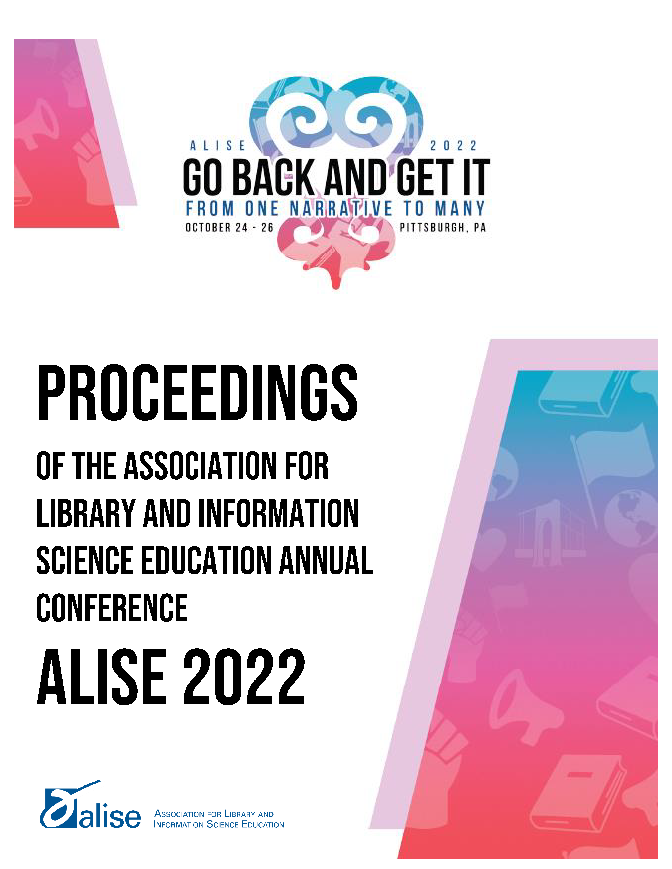Librarians’ Attitude Towards Providing Environmental Education Services in Their Community
DOI:
https://doi.org/10.21900/j.alise.2022.1076Keywords:
environmental literacy, environmental education, libraries, GIS analysisAbstract
The International Federation of Library Associations and Institutions (IFLA) advocates for libraries’ contributions to the global sustainable development efforts. Environment sustainability is one of the three pillars of the United Nations sustainable development concept. It’s crucial to examine libraries’ stance on environmental sustainability to see how they align with the professional organizations’ position. Case studies on libraries’ environmentally sustainable practices and services are plentiful. However, there is still the need for more empirical research that systematically examines libraries’ position and practice on environmental sustainability and the roles libraries play in building environmentally sustainable communities. This study fills the gap by surveying librarians from three states in the United States. The findings will be of interest to library associations to better support their member libraries in this endeavor. The findings are also important to LIS educators if they consider embedding environmental sustainability or environmental issues in LIS courses.
References
Affordable Learning Georgia. (n.d.). USG libraries. Retrieved September, 2020, from
https://www.affordablelearninggeorgia.org/library_resources/usg_libraries
Aldrich, R. S., Tanner, R., Antonelli, M., Dallas, S., Ho, A. K., Lesneski, T. E., Woodruff, M., &
Zabriskie, C. (2018). Report of the ALA special task force on sustainability. https://connect.ala.org/HigherLogic/System/DownloadDocumentFile.ashx?DocumentFileKey=dda45277-a902-11f0-ca0a-c56206aa864c&forceDialog=0#:~:text=The%20ALA%20Special%20Task%20Force%20on%20Sustainability%20was%20formed%20in,initiatives%20to%20further%20this%20work.
American Library Association (ALA). (n.d.). Resilent communities: Libraries respond to
climate change. https://www.ala.org/tools/programming/climatechange
Antonelli, M. (2008). The green library movement: An overview and beyond. Electronic Green
Journal, 1(27). https://doi.org/10.5070/G312710757
Antonelli, M., & McCullough, M. (Eds.). (2012). Greening libraries. Library Juice Press, LLC.
Beutelspacher, L., & Meschede, C. (2020). Libraries as promoters of environmental
sustainability: Collections, tools and events. IFLA Journal, 46(4), 347-358. https://dx.doi.org/10.1177/0340035220912513
California State Library. (n.d.). California public library directories. Retrieved September,
, from https://www.library.ca.gov/services/to-libraries/library-directory/
Calloway, M., & Callahan, D. (2003). Paper use and recycling in academic libraries. E-JASL:
The Electronic Journal of Academic and Special Librarianship, 4(2-3). https://southernlibrarianship.icaap.org/content/v04n03/Calloway_m01.htm
Christensen, K. (2010). Sustainability in collection development: Seeing the forrest and the
trees. Against the Grain, 22(6), Article 7. https://doi.org/10.7771/2380-176X.5685
Dias, S. M. (2017). Environmental sustainability for public libraries in Portugal: A first
approach. Electronic Green Journal, 1(40). https://doi.org/10.5070/G314029905
Edwards, M. M., & Thornton, E. (2013). Library outreach: Introducing campus childcare providers to the academic library. Education Libraries, 36(2), 4-16.
Florida Division of Library and Information Services. (n.d.). Libraries. Florida Department of
State. Retrieved September, 2020, from https://dos.myflorida.com/library-archives/research/florida-information/libraries/
Georgia Public Library Service (n.d.). Georgia public library directors. Retrieved September,
, from https://georgialibraries.org/publiclibrarydirectors/
Harrington, E. G., & Beale, H. (2010). Natural wonders. Children & Libraries, 8(1), 41-46.
https://doi.org/10.5860/cal.8n1
International Federation of Library Associations and Institutions (IFLA). (2016). Access and
opportunity for all: How libraries contribute to the United Nations 2030 agenda. https://repository.ifla.org/handle/123456789/243
Jankowska, M. A., & Marcum, J. W. (2010). Sustainability challenges for academic libraries:
Planning for the future. College & Research Libraries, 71(2), 160-170. https://crl.acrl.org/index.php/crl/article/viewFile/16069/17515
Kang, Q. (2018). Library directors’ concerns and attitudes towards going green and sustainability
in China: An unexplored area. Journal of Librarianship and Information Science, 52(2),
-398. https://doi.org/10.1177%2F0961000618818874
Love, C. B., Szczur, M., Higgins, M. W., & Aspinall, E. E. (2005). Tox Town: An Internet
introduction to environmental health and toxic chemicals. Children Youth and Environments, 15(1), 307-318. https://www.jstor.org/stable/10.7721/chilyoutenvi.15.1.0307
Smith, M. (2010). Getting there from here: Changing the ecological and social footprint of our
professional conferences. Against the Grain, 22(6), Article 11. https://doi.org/10.7771/2380-176X.5689
Spencer, R. M. (2010). K-12 environmental education resources. Against the Grain, 22(6), Article 13. https://doi.org/10.7771/2380-176X.5691
United Nations (UN). (2015). Transforming our world: The 2030 Agenda for Sustainable
Development.
https://www.un.org/ga/search/view_doc.asp?symbol=A/RES/70/1&Lang=E
Urbanska, W. (2009). What are vendors doing to help libraries GO GREEN? a lot. American Libraries, digital supplement (spring), 46-47. https://www.jstor.org/stable/26197524
Downloads
Published
Issue
Section
License
Copyright (c) 2022 Xiaoai Ren, Jia Lu

This work is licensed under a Creative Commons Attribution-ShareAlike 4.0 International License.



